Tier 10 (continued)
101. Christopher Morel (2B/3B/OF, CHC) – Morel is still without a regular position due to his subpar defensive skills, but his raw power suggests he could hit 30 or more home runs in a season if he managed to make contact on a more consistent basis. Morel’s strikeout woes are well-documented, though, and his decision-making skills declined as the season went on (see below). The low contact ability means Morel needs to make good decisions at all times, and until he can pull that off, he’ll remain an extremely volatile player.
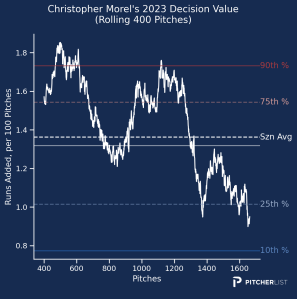
102. Anthony Volpe (SS, NYY) – The fact Volpe played 159 games and knocked 21 home runs with 24 steals made his 2023 a success even if it fell short of the lofty expectations of prospect chasers. Expect Volpe to improve on his counting stats and ratios in his second full season with an improved supporting cast, and if he can dig his way out of the bottom of the order, he could become a top-50 hitter before you know it. There is, of course, the risk that the strikeouts don’t come down and he continues to post subpar ratios that force the Yankees to bury him in the lineup, but that would be lame and not fun so I’m trying not to think about it.
103. Jordan Walker (OF, STL) – The highly-hyped prospect didn’t have the debut we hoped for, but to be fair, a 116 wRC+ as a 21-year-old is nothing to sneeze at. A demotion to the minors in May and summer slump were disappointing (and not entirely his fault), but it was good to see Walker rebound late in the season, slashing .302/.376/.497 from August 9 to the end of the season that very importantly included almost as many fly balls as grounders. I was encouraged by that growth because it’s the secret to unlocking his power potential, and also by the fact that Walker was not at all phased by major league breaking balls—a very common issue that you’ll hear me talk about throughout these rankings. 2024 could very well be the breakout year for Walker.
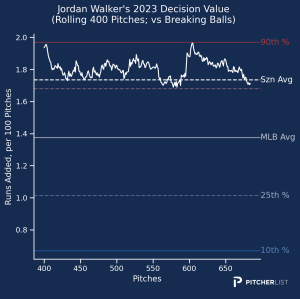
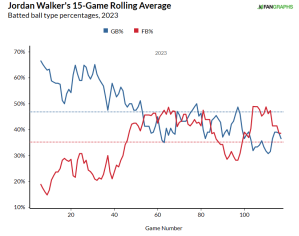
104. Lars Nootbaar (OF, STL) – Injuries once again limited Nootbaar to fewer than 120 games in the big leagues, but he still managed to show the power, speed, and on-base skills that caught our attention in 2022. Nootbaar looks like a good fit for the top third of the lineup, and if he can seize that opportunity, we could be looking at 23-25 home runs, 150-160 combined runs and RBI, 13-15 steals, and solid ratios. Those are all dependent on health and lineup position, though, and Nootbaar has yet to show consistency with either, but the upside is very real.
105. Zack Gelof (2B, OAK) – I was quite harsh on Gelof during the regular season due to his weird swing, his poor zone contact numbers, and his inflated line drive rates. While Gelof did improve his zone contact to an extent as the season went on, my lack of faith in players who miss more than 20% of the pitches they swing at in the zone remains as steadfast as ever.
Gelof’s mechanics aren’t enough to prove to me that he can sustain a line drive rate close to 30% as he had for most of the season in 2023, but I do admit the power is legitimate and the A’s will play him near the top of the order every single day. 20 home runs and 20 stolen bases are very much in play for Gelof (and 25 home runs wouldn’t shock me either), but the strikeout rate and luck regression will likely bring that batting average closer to .230.
Tier 11
106. Kerry Carpenter (OF, DET) – Carpenter is a power-first outfielder who could hit 30 home runs in a full season, though his vulnerability to left-handed pitching makes him a platoon risk. I think the batting average will be around .260 and he’ll get plenty of counting stats when in the lineup, so all that’s left is for him to start in 140 or more games to exceed this ranking.
107. Lourdes Gurriel Jr. (OF, ARI) – If you read the Hitter List over the last two seasons, then you know that I struggle to know what to do with Gurriel. The dizzying highs and terrifying lows we get from him throughout a season make Gurriel a player you can’t merely plug into your lineup and forget about, and the ups and downs don’t correlate with standard splits (like righty/lefty or home/away).
Gurriel enters 2024 as a free agent, and while he certainly could hit 20-25 home runs with a .270 average (this would be a high-end projection for sure), his wide range of outcomes has me pushing him down my list unless he lands in an ideal situation somehow.
108. Ezequiel Tovar (SS, COL) – It was great to see Tovar get a chance to play the full season as the primary shortstop for the Rockies, even if it came with lackluster results. While I desperately wish I had a rolling chart to show you that indicates growth or improvement, I wasn’t able to find anything of the sort. Growth doesn’t always happen on the field, though, and the one-time top-50 prospect has a good enough hit tool to hit .280 in the big leagues while throwing in 17-19 home runs and close to 15 steals along with whatever counting stats are available in Colorado, but until we start seeing actual signs on the field, it’s hard to call him anything more than an upside play
109. Jeimer Candelario (1B/3B, CIN) – Candelario could not have asked to be dropped into a better position as he’ll be hitting in the middle of the order for the up-and-coming Reds with a secure, everyday role. He may not repeat the eight steals he had in 2023, but look for Candelario to match or beat his home run, runs scored, and RBI totals in Cincinnati and push for a finish inside the top-100 hitters. His ceiling and floor probably aren’t that far apart, but it’s of high enough quality that we don’t mind the lack of explosive upside.
110. Chas McCormick (OF, HOU) –McCormick was another player I was very skeptical of last season due to his poor zone contact rate and his inflated line drive rates around the middle of the season, but to his credit, McCormick continued to produce (albeit to a lesser extent) when the line drive rate started to return to normal, hitting nine home runs and stealing eight bases over his last 50 games.
McCormick truly shines against lefties, posting a 177 wRC+ against them in 2023 and a 163 wRC+ against them over his career while being merely average against right-handed hitting. That weakness to righties caps McCormick’s upside a bit, but his strong defense and 2023 breakout should help him eclipse 120 games played for the first time in his big league career while giving him a path to a 20-20 season. The batting average is a question mark and any prolonged slump could lead to a platoon, but as long as he’s in the lineup the power and speed should be there.
111. Christian Encarnacion-Strand (1B/3B, CIN) – The young slugger still has a lot of work to do on his decision-making, but the raw power started to shine towards the end of the season. Decision-making is a much more “learnable” skill than contact ability or power, so hopefully an offseason and more time with the big league club will get Encarnacion-Strand where he needs to be to unlock his peak 35+ home run power. Playing time is a huge issue due to the very crowded infield (especially at the corners) in Cincinnati, so for now CES remains a lottery ticket.
112. Sean Murphy (C, ATL) – It was a tale of two halves for Murphy, who posted a .999 OPS with 17 home runs and 97 combined runs and RBI in the first half only to suddenly start riding the pine three to four days a week (which started in June) and struggled to the tune of a .585 OPS and just four home runs and 33 combined runs and RBI in the second half. It was a truly baffling collapse for him, as his strong defense behind the plate would normally have him starting most days. That timing suggests that maybe the hamstring issue that popped up in June impacted him throughout the season, but we have yet to be given any concrete information about why his role changed so suddenly. That lack of insight makes me extremely worried about relying on him in 2024, but the upside from the first half necessitates that I rank him in the top 150.
113. Cal Raleigh (C, SEA) – It’s safe to expect that Raleigh will hit home runs with a low batting average once again in 2024, and the fact that Seattle also lets him DH when he’s not behind the plate means that he’ll get more plate appearances than the usual catcher as well. Raleigh can be streaky due to his power-only approach, but as long as you have the patience to ride out the bad times, he makes for a solid fantasy catcher.
114. Noelvi Marte (3B, CIN) – Marte flashed speed and a bit of power in his brief 2023 debut and he should have a clear path to being the everyday third baseman for the Reds in 2024. Marte was considered a top 20 prospect as recently as 2022, and his pedigree reinforces the notion that he could put up something close to a 20-20 season with above-average ratios. Marte has only played 74 games above Double-A which makes any projection risky, but if you need an upside play at the hot corner, Marte makes for an intriguing pick.
115. Edouard Julien (2B, MIN) – In his very first exposure to the majors and being only 24 years old, Julien showed he is and will likely continue to be among the best decision-makers in the league (see below) and can punish fastballs.
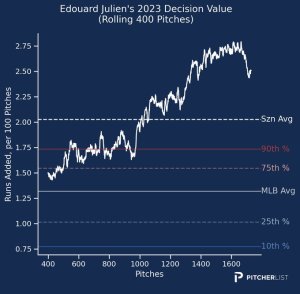
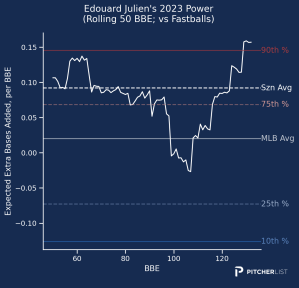
This is an excellent starting point to launch a successful 2024 season, though it’s worth noting that there are weaknesses in how he performs in both contact and power against breakers and offspeed pitches. That particular weakness isn’t unique to Julien, though, as many young players struggle to adjust against how well major league pitchers can use these weapons compared to minor leaguers. I believe there’s room for Julien to learn how to deal with these pitches, and it could lead to 20 home runs with 90+ runs scored if he can stay at the top of the Twins’ lineup.
116. J.D. Martinez (UT, FA) – J.D. found his power again last season for the Dodgers, hitting 33 home runs in just 113 games and driving in 103 runners. He’d deserve a higher ranking than this if we knew he’d be heading back to LA, but he’s definitely not headed back there and there’s plenty of uncertainty on his landing spot, so we have to hedge our bets a bit for now.
117. Trevor Story (2B, BOS) – I remain pretty low on Story, unfortunately, as he’s simply been unable to find any health or consistency since moving to Boston. Strikeouts continue to plague him as he’s maintained a strikeout rate of over 30% since joining the Red Sox, and while injuries may be partially to blame, I expect health will remain an issue going forward.
This ranking respects that a healthy Story could certainly hit 20 home runs and steal 25 bases in 140 games or so, but that version of Story has been fleeting of late. It’s a big-time risk-reward pick that could work out very well, but I wouldn’t make this bet unless I also intended to take a second player with second-base eligibility. For what it’s worth, this ranking would be considerably lower in draft-and-hold formats and other deeper leagues, but the replacement level in standard leagues is high enough that it can’t hurt you that much if it’s a swing and a miss.
Tier 12
118. Jeremy Peña (SS, HOU) – Peña’s 2023 was an improvement in some areas, such as plate discipline and OBP, but it came with a huge downturn in power thanks to a much higher groundball rate that he was not useful for fantasy. If Peña can get back to 20 home runs to go with his improvements at the plate and his 13-15 stolen bases, he could be a very steady contributor in the middle infield. If he once again barely manages double-digit home runs, he’s not worth rostering in 12-teamers. The one thing Peña has going for him, though, is that his glove will keep him in the lineup every day, meaning he’ll have every opportunity to find a way back to his 2022 self.
119. Nolan Gorman (2B/3B, STL) – The 27 home runs in 119 games isn’t that surprising for those who followed Gorman as a prospect, and neither is the 32.3% strikeout rate he’s shown in 208 career games in the majors. Gorman’s extreme contact issues make him a wildly volatile player in both real life and fantasy, especially since he’s not especially good at making contact even when he’s not chasing pitches. The Cardinals weren’t afraid to bench him against lefties and shuffle their lineup around to cover for it, and I do expect that to continue until Gorman adjusts.
120. Andrew Vaughn (1B, CWS) – Vaughn has increased his home run, runs scored, and RBI totals in each of his three major league seasons, but that’s about where the good news ends for those who have waited for Vaughn to justify his former standing as a top 20 prospect.

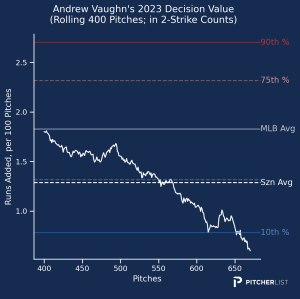
Vaughn is quite good at making contact and has slightly above-average power, but his rising aggression in 2023 led to lots of bad swing decisions, especially in two-strike counts. Unless he can find a way to make good decisions on a more consistent basis, the Vaughn we’ve seen in 2022 and 2023 is probably the Vaughn we’re going to continue to get. I’m holding out hope that there’s one more level to his game, but if we don’t see it in 2024, I’ll finally be ready to completely move on.
